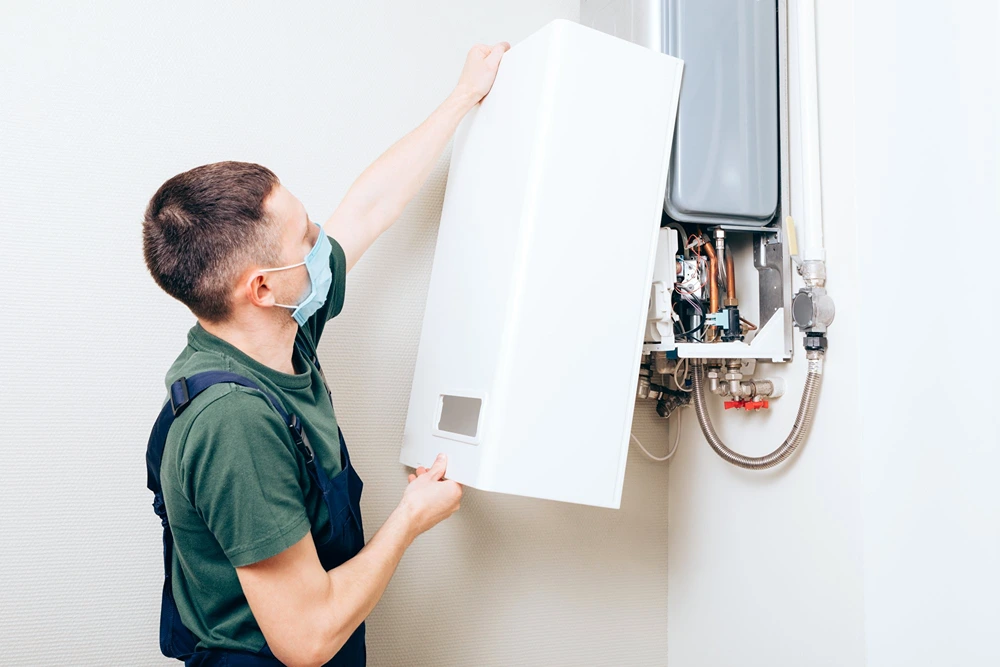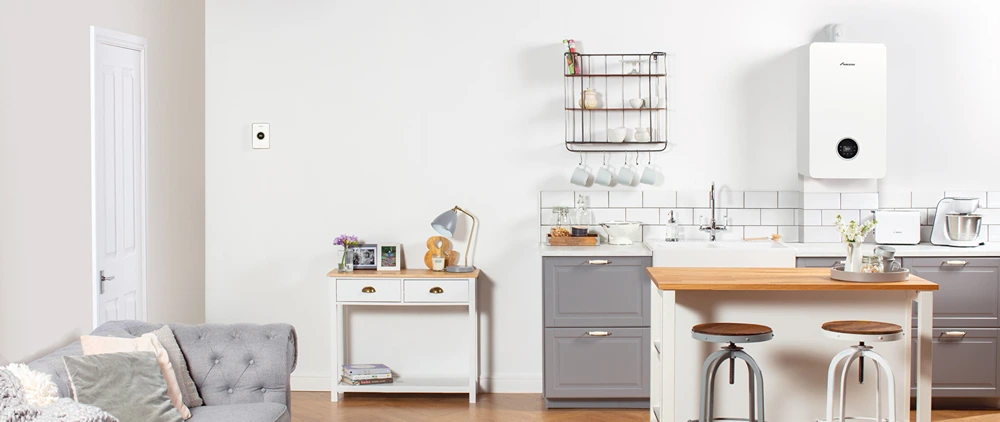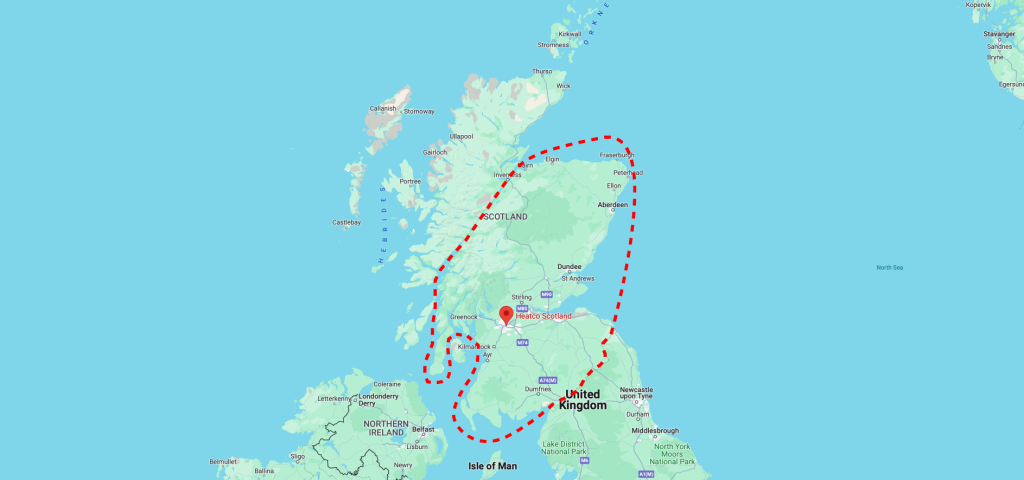How frustrating can it be to spend money on a new boiler installation without knowing what to expect? For homeowners in Glasgow and central Scotland, a boiler installation doesn’t have to be a mystery. This detailed guide will take you step-by-step through the entire process, starting from the initial consultation to the final paperwork and post-installation tips. Dive in to understand how HeatCo Scotland Ltd ensures that your home remains warm, comfortable, and energy-efficient throughout the year.

Initial Consultation and Boiler Assessment
The boiler installation process starts with an initial consultation and assessment by a qualified heating engineer.
What does the engineer evaluate during the assessment?
The engineer evaluates the current heating system, home size, number of radiators, and available fuel type. These factors are critical in determining the most suitable boiler for the property.
Why is evaluating the current heating system important?
Evaluating the current heating system helps identify any existing issues and ensures that the new boiler will integrate seamlessly with the existing infrastructure. Understanding how does a gas boiler work is crucial during this evaluation. A gas boiler operates by igniting natural gas or propane to heat water, which then circulates through your home’s radiators or underfloor heating to provide warmth. This process is efficient and reliable, making it a popular choice for many homeowners. By knowing how your gas boiler functions, you can better appreciate the importance of a thorough system evaluation. This evaluation includes checking the condition of pipework, radiators, and overall system efficiency.
What role does the home size play in the assessment?
Home size impacts the heating requirements. Larger homes may require a more powerful boiler or even multiple units to ensure adequate heat distribution. Conversely, smaller homes may benefit from compact and efficient models.
How does the number of radiators influence the boiler choice?
The number of radiators is directly proportional to the heating load. More radiators require a boiler with a higher output capacity to maintain consistent heating throughout the home.
Why is the available fuel type a consideration?
The available fuel type (such as natural gas, oil, or LPG) affects the type of boiler that can be installed. Each fuel type has specific boilers designed for optimal performance and efficiency.
What else does the engineer consider?
The engineer also considers the homeowner’s budget and energy efficiency preferences. Energy-efficient boilers can offer long-term savings on energy bills, which is a significant factor for many homeowners.
What types of boilers might the engineer recommend?
Based on the assessment, the engineer recommends suitable boiler options, such as:
- Combi Boilers: Ideal for smaller homes with limited space.
- System Boilers: Suited for properties with more than one bathroom.
- Conventional Boilers: Best for homes with traditional heating systems requiring a separate hot water cylinder.
The initial consultation and assessment phase is crucial for planning a successful boiler installation. Understanding the benefits of installing a new boiler can greatly influence your choice. A new boiler can offer improved efficiency, reduced energy bills, and enhanced home comfort. Additionally, modern boilers often come with advanced features such as smart controls and better safety mechanisms. By recognizing these benefits, homeowners can make informed decisions that align with their heating needs and financial considerations. It ensures that the selected boiler meets the specific needs of the home and the homeowner, leading to an efficient and reliable heating system.

Preparing for Boiler Installation Day
What should homeowners do to prepare for boiler installation day?
Homeowners should clear the installation area to facilitate easy access for the engineer. This involves moving any furniture or obstructions and ensuring the area is clean.
What pre-installation tasks might the engineer handle?
The engineer might need to upgrade the pipework or install a new flue to ensure compatibility with the new boiler. These upgrades are essential for ensuring the system operates efficiently and safely.
How does the engineer prepare the installation area?
The engineer will begin by removing the old boiler and checking the condition of the existing pipework. Ensuring the installation area is safe is a priority, and any necessary adjustments will be made.
What measures are taken to protect the home during installation?
Dust sheets are laid down to protect your space from debris and minimise disruption. This helps maintain cleanliness and reduces the post-installation clean-up.
What is the importance of scheduling the installation date?
Scheduling a specific date for installation ensures that both the homeowner and the engineer are prepared. It also allows time for any preliminary work, such as pipework upgrades, to be completed in advance.
Why is it important to ensure the installation area is safe?
A safe installation area is crucial for the engineer to work efficiently and for the boiler to be installed correctly. This includes checking for any potential hazards and making necessary adjustments to facilitate a smooth installation process.
By following these steps, homeowners can ensure a smooth and efficient boiler installation, minimising disruptions and ensuring the new system is set up correctly.
Step-by-Step Boiler Installation Process
Removal of Old Boiler
How does the engineer decommission and remove the old boiler?
The engineer starts by isolating the boiler from the gas supply and draining any remaining water from the system. This ensures that the removal process is safe and free from hazards.
How long does the removal process take?
The decommissioning and removal of the old boiler can take several hours, depending on the complexity and condition of the existing system. The engineer will disconnect the boiler from the pipework and power sources before physically removing it.
Why is it necessary to remove the old boiler thoroughly?
Thorough removal is essential to prevent any compatibility issues with the new system. When considering a boiler replacement, it’s crucial to ensure that the old unit is completely decommissioned and removed. This process not only makes way for the new installation but also allows for a detailed inspection of existing infrastructure. By understanding when and why to replace your boiler, you can avoid potential pitfalls and ensure a seamless transition to a more efficient heating system. The engineer will also inspect the existing pipework to ensure it is in good condition and suitable for the new boiler.
Installation of New Boiler
What are the steps involved in placing the new boiler?
The engineer will first position the new boiler in the designated area, ensuring it is level and securely mounted. Understanding the timeline of a boiler installation can help homeowners plan accordingly. Typically, the installation process can take one to two days, depending on the complexity and specific requirements of the home. By knowing what to expect in terms of duration, homeowners can better prepare for any temporary disruptions and ensure a smooth transition to their new heating system.
How are connections made to the pipework and gas or oil supply?
The new boiler is connected to the existing pipework, which may involve cutting and adjusting pipes to ensure a perfect fit. The gas or oil supply is then connected, and the engineer will ensure that all connections are secure and leak-free.
What other connections are necessary during installation?
In addition to pipework and fuel connections, the boiler will be connected to the electrical system. This is crucial for the boiler’s control functions and safety features.
Safety Checks and System Integration
What critical safety measures are taken during installation?
Safety is paramount. The engineer will perform a series of checks to ensure that the installation is safe and compliant with regulations. This includes checking for gas leaks, ensuring proper ventilation, and verifying that all connections are secure.
How is the new boiler integrated with the home’s heating system?
Once the boiler is installed and connected, it will be integrated with the home’s heating system. This involves connecting it to the radiators, hot water cylinder (if applicable), and any thermostats or control systems.
What final checks are performed to ensure proper operation?
The engineer will conduct thorough testing to ensure the boiler operates correctly. After the installation, post-installation checks and demonstration are vital to confirm the system’s functionality and safety. These checks include leak detection, operational testing, and verifying safety features. Additionally, the engineer will provide a demonstration on how to operate the new boiler, covering thermostat settings and any additional controls. This ensures homeowners are comfortable with their new system and can use it efficiently from day one. This includes firing up the boiler, checking the pressure, and ensuring that hot water and heating are distributed evenly throughout the home. Any adjustments needed to optimise performance will be made at this stage.
How long does the entire installation process take?
The installation process typically takes one to two days, depending on the complexity of the job and the size of the home. This timeline includes removing the old boiler, installing the new one, performing safety checks, and integrating the system.
By understanding these steps, homeowners can better prepare for a smooth and efficient boiler installation, ensuring their new system operates safely and effectively.

Post-Installation Checks and Demonstration
What happens after the boiler installation is complete?
After the installation is complete, the engineer will conduct a series of thorough tests to ensure that the system functions correctly. This includes checking for any leaks, verifying that the boiler heats water and radiators properly, and ensuring overall efficient operation.
Why are these tests important?
These tests are crucial because they confirm that the boiler is installed safely and operates efficiently. Identifying potential problems at this stage can prevent future issues and costly repairs.
What specific checks are performed?
The engineer will perform several specific checks, including:
- Leak Detection: Ensuring there are no gas or water leaks in the system.
- Operational Testing: Verifying that the boiler heats water and radiators efficiently.
- Safety Features: Testing the pressure relief valve and carbon monoxide detector to ensure safety.
What role do safety features play in post-installation checks?
Safety features like the pressure relief valve and carbon monoxide detector are essential for preventing hazardous situations. The engineer will confirm that these features are functioning correctly to ensure the safety of the household.
How does the engineer demonstrate the new boiler to the homeowner?
Once all checks are completed, the engineer will provide a demonstration on operating the new boiler. This includes:
- Thermostat Settings: How to adjust and set the thermostat for optimal comfort.
- Additional Controls: Explanation of any additional controls or features, such as timers or smart thermostats.
What documentation is provided to the homeowner?
Important documentation will be provided, including:
- Warranty Information: Details of the boiler’s warranty, which is crucial for future repairs or replacements.
- Maintenance Instructions: Guidelines on how to maintain the boiler to ensure its longevity and efficient operation.
Why is the provided documentation important?
The documentation is vital because it includes information on how to operate and maintain the boiler effectively. It also contains warranty details, which are essential for addressing any future issues under the manufacturer’s guarantee.
By understanding the post-installation checks and demonstration, homeowners can ensure their new boiler is set up correctly and know how to operate it safely and efficiently.
Final Paperwork and Certification
What paperwork is completed after a boiler installation?
The engineer completes any necessary paperwork, including providing a certificate of installation. This certificate confirms that the boiler has been installed according to industry standards and complies with safety regulations.
Why is the certificate of installation important?
The certificate of installation is crucial as it verifies that the installation meets all required safety and operational standards, ensuring the system is safe and efficient for use.
What happens with building control certification?
The boiler will be registered for building control certification. This registration is mandatory and ensures that the installation complies with local building regulations.
How is the manufacturer’s warranty activated?
The engineer will activate the manufacturer-backed warranty, which protects against potential defects and provides coverage for repair or replacement within the warranty period.
How is the paperwork delivered to the homeowner?
Paperwork, including the certificate of installation and warranty details, will be sent either by post or email. This ensures that homeowners have all necessary documentation for future reference.
Understanding these final administrative tasks is essential for ensuring your new boiler is legally compliant and covered by the manufacturer’s warranty.

Tips for Homeowners During and After Installation
What should homeowners do to prepare for the boiler installation?
Homeowners should clear the installation area. This involves moving any furniture or obstructions to provide easy access for the engineer. A clean and accessible area facilitates a smoother installation process.
Why is understanding the basic operation of the new boiler important?
Understanding the basic operation of the new boiler is crucial for efficient use. Knowing how to adjust settings and use the controls helps in maintaining optimal performance and comfort. The engineer will provide a demonstration and instructions on how to operate the boiler effectively.
What are the benefits of regular maintenance?
Regular maintenance minimises repair needs and extends the boiler’s lifespan. Scheduled maintenance ensures that the boiler operates efficiently and safely. Common maintenance tasks include checking the pressure, bleeding radiators, and inspecting the system for leaks or potential issues.
What should homeowners monitor after installation?
Homeowners should monitor the boiler for any unusual noises, fluctuations in pressure, or inconsistent heating. Early detection of issues can prevent more significant problems and costly repairs. Keeping a close eye on the system helps maintain its efficiency and reliability.
Why is it recommended to take out a home cover service policy?
A home cover service policy is recommended to maintain the boiler warranty and ensure regular professional inspections. Such policies often cover annual servicing, repairs, and emergency call-outs, providing peace of mind and financial protection against unexpected breakdowns.
What guidance will the engineer provide?
The engineer will offer guidance on regular maintenance routines, including how to check the pressure, bleed radiators, and identify common issues. This knowledge is essential for homeowners to keep their boiler running efficiently between professional services.
By following these tips, homeowners can ensure their new boiler operates efficiently and reliably, maximising its lifespan and performance. Regular maintenance and proper operation are key to enjoying the full benefits of a new boiler installation.
Final Words
In the action, a new boiler installation starts with an initial consultation and assessment. This phase includes evaluating the current heating system, home size, and budget to recommend a suitable boiler. Preparing for installation day involves ensuring the site is ready and upgrading necessary components. The engineer then follows a step-by-step process to install and integrate the new boiler, performing safety checks and system tests.
Post-installation, thorough testing and a user demonstration are crucial. Necessary paperwork, including certification and warranties, ensure compliance and peace of mind. Understanding what to expect during a boiler installation can make the process smoother and more efficient for homeowners.
FAQ
What to expect during a boiler installation Worcester Bosch?
A: During a Worcester Bosch boiler installation, expect a qualified engineer to assess your system, remove the old boiler, install the new one, and perform safety checks, including testing for leaks and ensuring proper functioning.
Can you use the toilet when the boiler is being replaced?
A: Yes, you can use the toilet while the boiler is being replaced. However, water may be temporarily shut off, affecting usage briefly.
How do I prepare my boiler for installation?
A: Preparing for boiler installation involves clearing the area around the old boiler, ensuring access to radiators, and removing obstructions. Pre-installation checks may include upgrading pipework or installing new flues.
Is replacing a boiler a messy job?
A: While replacing a boiler can be messy, engineers use dust sheets and take steps to minimise disruption and clean up thoroughly after the job.
Do you need access to all radiators when fitting a new boiler?
A: Yes, access to all radiators is needed to check and balance the system, ensuring even heat distribution and proper boiler functionality.
What is the boiler installation procedure?
A: The boiler installation procedure involves removing the old boiler, assessing and preparing the installation site, placing the new boiler, connecting it to existing pipework and electrical systems, and performing safety tests.
What to expect when having a new boiler fitted?
A: When fitting a new boiler, expect an initial assessment, removal of the old boiler, installation of the new one, integration with the heating system, and comprehensive safety checks.
What to expect during a boiler installation combi boiler?
A: During a combi boiler installation, expect the engineer to remove the old unit, install the new combi boiler, make necessary connections, perform safety checks, and explain the system’s operation.


